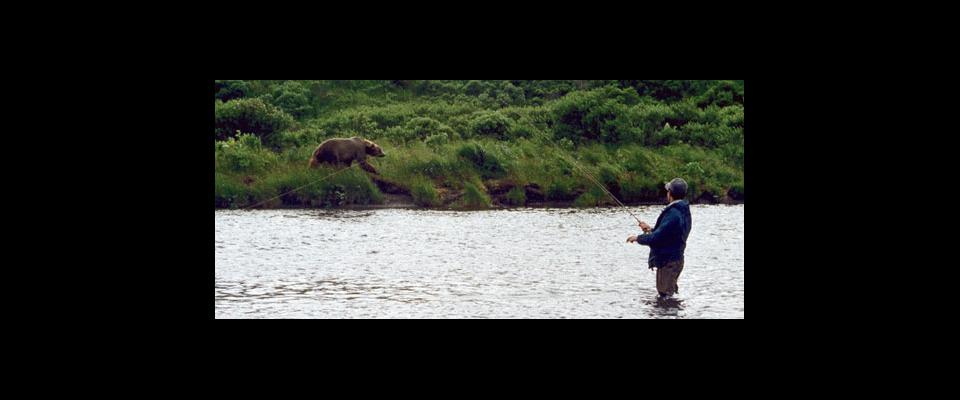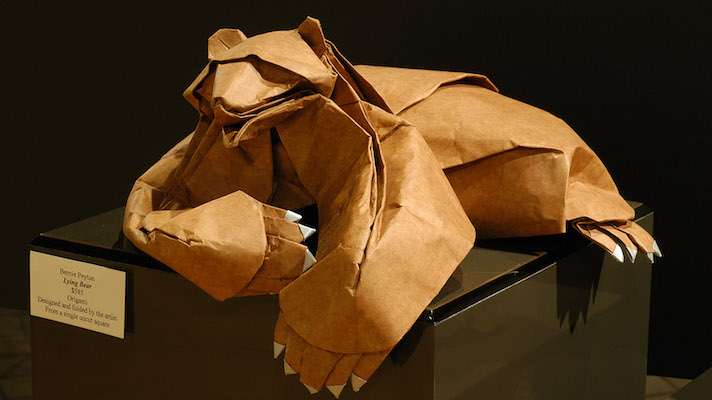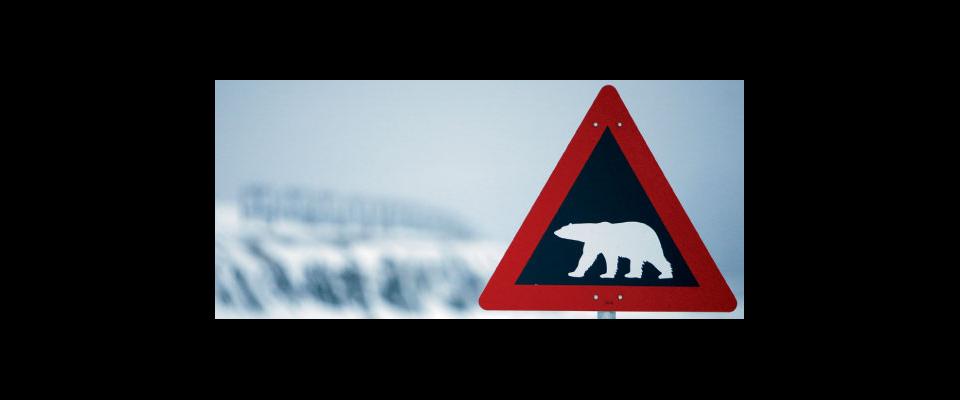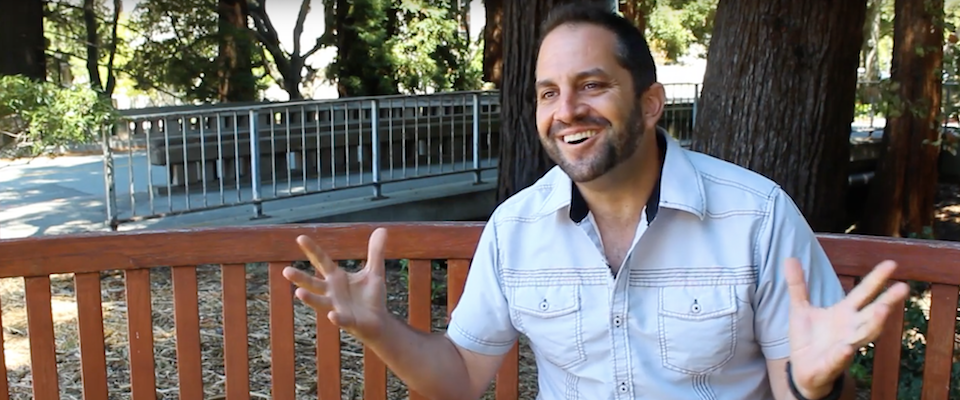Fishing with the bears in Kodiak.
Our first days on the island were windy and wet and the air taxi wouldn’t fly us out to the lake, so we killed time reading aloud from a book called Alaska Bear Tales, harrowing Man vs. Bear stuff in which men generally got the worst of it—individual men anyway; Man has managed to keep the upper hand. While one of us read, the others took turns tying up brightly colored flies with gaudy names like “green-butt skunks” and “pink stinkers” and “egg-sucking leeches.” When I asked a guy in the sporting goods store if leeches were actually known to suck eggs, he just laughed. He laughed too when I asked what he thought of pepper spray as a bear deterrent. He called it “spicy hiker.”
There were four of us on this trip: Steve and his brother Todd, both doctors; Joe, a computer programmer; and me. When the motel room gave us cabin fever, we wandered around town. At one of the taverns, I played pool with a kid from Chico who worked as deckhand on a crab boat. He shuffled around the table in rubber boots, deliberating over each shot. I asked him if he ever got seasick. “The first time we hit rough seas,” he answered, “I’ll puke every color in the crayon box.” You get over it, he said.
Between games I went to fetch more beers. On the bar was a copy of the local paper, folded open to a story about the Reverend Sun Myung Moon getting busted by Alaska game wardens. According to the report, the spiritual leader was in possession of twice the legal limit of coho salmon. I was dimly aware that Moon was an angling fanatic, but the story revealed a much more extensive involvement with fish. Seems he owned a seafood processing plant on the island, plus many of the boats in Kodiak Harbor. The wardens had caught not only one of the world’s most notorious cult leaders, but also Kodiak’s largest employer.
I looked back over my shoulder at the kid, who had re-racked the balls and was preparing to break. “He doesn’t look like a Moonie,” I thought. And then I thought, “Or maybe that is what Moonies look like.”
On the third day, the skies finally cleared. We staged our gear and provisions on the end of the dock where the plane was tied up. Our pilot, who looked and sounded like the actor Sam Elliott in The Big Lebowski (“Sometimes you eat the bar, and sometimes, well, he eats you”), gave his mustache a twist as he looked over our stuff. “You carrying any protection?” he asked.
“You mean like bear bells?” Steve asked.
The pilot cocked an eyebrow. “I mean firearms,” he said. A little sheepishly, I told him that, since none of us knew much about guns, we’d decided not to risk it. To my surprise and relief, he said he thought that was smart. He’d once had to med-evac a guy who’d shot his toes off while lying in his sleeping bag. The man had been so frightened, apparently, that he didn’t dare sit up; just pulled the trigger and blam! “Scared the bear away from his tent, all right,” the pilot said. “Damn near bled to death, too.”
Fortunately, we’d be in a cabin on this trip. Nothing fancy—four walls and a roof, property of the Kodiak National Wildlife Refuge—but it sure beat the idea of spending the nights in a flimsy nylon shelter.
The flight to the lake was short but spectacular. We saw a whale in one of the channels, red salmon in the rivers, the white heads of eagles dotting the landscape. We also saw two bears, one of which took off running as we came buzzing overhead, then reared up as if to swat us out of the sky. When we arrived at the lake, we unloaded the gear, and the pilot advised us to keep our raft moored off the beach. “The bears like to bounce on ’em,” he said. And then he was off, roaring up over the ridgeline and out of sight, to return in five days, weather permitting.
We lost no time, stowing our stuff in the cabin, then stringing our rods and piling into the raft. The outboard fired up on the first pull and we putted across the lake to the inlet stream. Watchful for bears, we fanned out across the mouth and commenced the familiar ritual: casting across the current, holding the rod high as the fly went searching downstream. If we didn’t get any strikes, we moved up, making slow, methodical progress. In just a couple of hours each of us landed a dozen or so fish. Occasionally we hooked a salmon or a rainbow trout, but mostly we caught Dolly Varden, a polka-dotted char that takes its name from a character in Dickens. We each kept one fish and released the rest.
After a while, we waded back downstream to the lake. The stench of rot was everywhere. There were salmon carcasses lining the river bottom, dead salmon decomposing on the banks, salmon caught in the sweepers, draped around the submerged branches like Dali’s watches. It didn’t do much for our appetite. As I stood midstream, a spawned-out sockeye—body bright red, head like a green dog-mask—came brushing up against me in the cold current. I shuddered a little as it slid past, gills still working, eyes blank as stones.
The days took on a routine. In the evenings, we cooked our catch and washed it down with wine or scotch. Most nights, we fished again after dinner, since by midnight the sun had barely dipped below the mountains. In the mornings, we ate pancakes and brewed coffee and visited the outhouse, where a previous guest had left a pack of smokes and a worn copy of More Alaska Bear Tales. This was our bathroom reading. As gripping as the stories were, the mauling accounts took on a kind of awful sameness. Invariably, they described the sound of teeth scraping against the skull. The survivors told of being tossed like rag dolls, of bones breaking on rocks and tree trunks, of having their buttocks repeatedly bitten. They complained about the breath.
I thought about those details the morning I looked downstream to see a bear slip out of the tall grass and into the river, maybe 40 yards from where I stood unknotting a leader. The bruin submerged itself hippo-like in a deep pool off the bank, then dipped its snout underwater and exhaled. A blast of breath bubbled to the surface.
We were fishing the outlet stream that day. A weir and a fish ladder had been built there that gave the sockeye access to the lake, and the bears easy access to the sockeye. From atop the bluff we watched the bears fish for some time and debated the wisdom of descending. A young biologist who was doing fieldwork there told us that the bears we saw below us were “habituated” to human presence, and the matter-of-fact way he said it was reassuring. Still, we must have looked dubious, because he shrugged and said, “People fish here all the time.”
With the bears right there, we asked?
“Yeah. If you told me you were going to fish a mile downriver from here, I’d caution against it.”
And so we went down to the river and began to fish. The bears were all around and sure enough, they seemed largely indifferent to our presence. But who could be certain? One very large bear appeared directly across the river from where I stood. For a moment, it sniffed the wind as if catching my scent, then lowered its head and looked directly at me. The fur on its back bristled in the wind. I had read somewhere that head-lowering was not a good sign. Head swinging was even worse. If that big head started swinging back and forth, there wouldn’t be much hope for me; if he decided to charge, he’d be on me in three lumbering strides. With nothing else to do, I raised the Pentax I had slung around my neck and focused. The shutter clicked once, twice, and then my subject turned his enormous rump to me and ambled off into the tussocks.
I don’t want to exaggerate here or offer up any false epiphanies, but the experience of seeing that great big bear up close was something I can only describe as awesome. That word has been abused and debased in our time, I know, but it’s the only word that will do; there was more awe in that moment for me than in a lifetime of churchgoing.
On the last day, before the plane returned to pick us up, I spent a couple of hours taking pictures of dead fish. It was a horror show, all those salmon with their eyes pecked out, entrails spilling across the sand; salmon stiff and leathery, jaws gaping or snarled in rictus; salmon reduced to puddles of flesh, bones sticking out. After a while, I gave the camera a rest and just sat down, as the salmon all around me dissolved quietly into the landscape of their birth.
Back in the town of Kodiak, we were still surrounded by bears. There were taxidermied specimens everywhere—in hotel lobbies and barrooms, museums and hardware stores. Waiting in Kodiak airport to catch the flight to Anchorage, I opened my notebook and sketched the bear that dominated the tiny terminal. A giant, it was posed on its hind legs, ears brushing the ceiling tiles. Beneath it a deer was frozen in mid-bolt, and the bear was just beginning to wheel around in pursuit.
Our species once revered and worshipped these creatures, and as I sketched, it occurred to me that this shaggy trophy, which before I had understood only as a sop to human vanity, might also be thought of as something more profound, something totemic—a symbol of our yearning for the spirit world, and an acknowledgment of the end that awaits us all.
I was thinking that—or, at least, something like that—when a woman walked up with her young daughter and stood at the foot of the display, both of them gazing upward.
“Ahh,” the mother cooed, “that’s a bi-i-i-g teddy bear.”





















